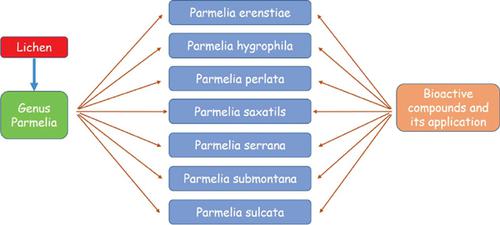Current Pharmaceutical Biotechnology ( IF 2.8 ) Pub Date : 2020-10-31 , DOI: 10.2174/1389201021666200406105212 Arumugam Dhanesh Gandhi 1 , Sivaji Sathiyaraj 1 , Gunasekaran Suriyakala 1 , Sivakumar Saranya 1 , Tirumalpur Neelakandan Baskaran 1 , Balasubramani Ravindran 2 , Ranganathan Babujanrthanam 1

|
Parmelia that belongs to the Parmeliaceae Family is a foliose lichen combined with one or two groups of fungi in Phylum Ascomycota or Basidiomycota and algae, which might be green algae or blue-green algae (cyanobacteria). It is generally called “Stone Flower,” “Charila,” “Pattharphool,” or “Shilaaapushpa” in India. Lichen can be generally found growing on walls, old trees and spread largely across India, especially in the mountain area. It is a source of edible organisms for people residing in some regions of Nepal and it is also cultivated in hillsides of Kashmir. It has been found that lichen contains a lot of distinctive chemical compounds such as evernic acid, lecanoric acid, lobaric acid, norstictic acid, physodic acid, and salazinic acid. Some species of this lichen are recommended traditionally for controlling diseases such as boils, bronchitis, inflammations, excessive salivation, toothache, vomiting, etc. It has also applied as an indicator for biomonitoring, astringent, carminative, demulcent, bitter, resolvent, emollient, laxative, sporofic, sedative, diuretic and considered for treating sores, bronchitis, excessive salivation, vomiting, tooth-ache, boils and inflammations. It has been utilized for preparing traditional food and acts as a bioindicator for air pollution and radiation. It shows antibacterial, antioxidant, antimycobacterial and antifungal activities, including haemolytic, anaesthetic, spasmolytic and antispasmodic and antitumour activities. It also has several unique phytoconstituents that could be in charge of different therapeutic activities, but the majority of them are still unexplored. The review mainly focuses on various facets, such as common names, synonyms, traditional uses, botanical descriptions, and pharmacological activities of seven species of Parmelia.
中文翻译:

Parmelia属地衣:概述及其应用
隶属于虎耳草科的虎耳草是一种叶状地衣,结合了一种或两种真菌,分别是绿藻或蓝藻和蓝藻(蓝藻)。在印度,通常将其称为“石花”,“ Charila”,“ Pattharphool”或“ Shilaaapushpa”。通常发现地衣生长在墙壁,老树上,并广泛分布在印度各地,尤其是在山区。它是尼泊尔某些地区居民食用生物的来源,也种植在克什米尔山坡上。已经发现地衣含有许多独特的化学化合物,例如壬酸,lecanoric酸,lobicic酸,norstictic酸,physdic酸和salazinic酸。传统上建议使用这种地衣的某些种类来控制疾病,例如煮沸,支气管炎,发炎,流涎过多,牙痛,呕吐等。它还被用作生物监测,收敛剂,矿物质,镇静剂,苦味,分解剂,润肤剂,缓泻剂,孢子质,镇静剂,利尿剂的指标,并被认为可用于治疗疮,支气管炎,唾液过多,呕吐,牙痛,煮沸和发炎。它已被用于制备传统食品,并作为空气污染和辐射的生物指标。它显示出抗菌,抗氧化,抗分枝杆菌和抗真菌活性,包括溶血,麻醉,解痉,解痉和抗肿瘤活性。它还具有几种独特的植物成分,可以负责不同的治疗活性,但其中大多数仍未开发。审查主要针对各个方面,例如通用名称,



























 京公网安备 11010802027423号
京公网安备 11010802027423号